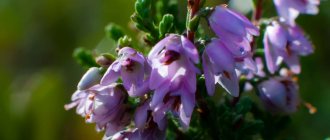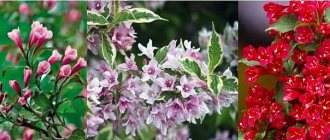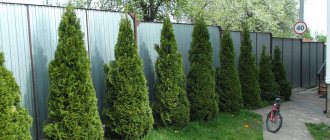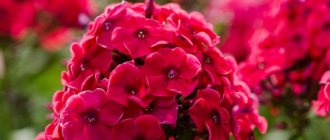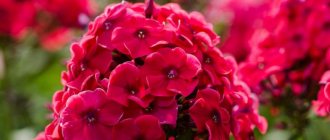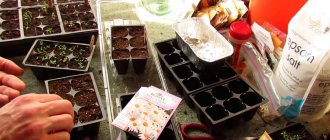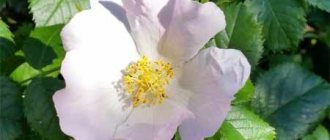The natural beauty of cypress has long attracted the attention of gardeners. Breeders who developed original varieties also added to its popularity.
The ability to give its crown any shape expands the options for using cypress in landscape design. We'll talk about what kind of care a handsome conifer needs .
Description and characteristics
On Earth, pea cypress is found in the countries of East Asia and North America . Cultivated varieties grow up to 2–3 meters, while wild plants grow beyond 20–30 meters.
Externally it is very close to cypress, but looks like this:
- the scaly bark covering the branches and trunk is red-brown;
- during natural formation, the crown takes on the appearance of a cone;
- the needles of young cypress trees acquire a scaly structure with age;
- bears fruit in cones with two seeds.
Interesting! Boulevard cypress is grown both outdoors and at home.
Dimensions
In its natural habitats, the cypress tree easily stretches to a height of 40 meters . The varieties grown here do not grow higher than 3–4 meters.
Gardeners prefer dwarf varieties whose dimensions do not exceed 70–100 cm.
Cold resistance
It is difficult for large trees to withstand Russian frosts, so low-growing varieties of cypress are cultivated .
They are easy to cover for the winter, providing reliable protection.
Just so you know.
genus ( Chamaecyparis ) of the cypress family includes seven species of coniferous trees, three of which grow in the United States, the remaining four in eastern Asia.
Pea cypress ( Chamaecyparis pisifera ) is a coniferous tree that naturally lives in the mountains of Japan, including on the northernmost of the Japanese islands - Hokkaido. The natural appearance has a low conical crown and short, pointed at the end, scaly needles. In its homeland, the tree can reach 25-30 meters in height, but its average height does not exceed 8-10m.
The pea cypress is one of the five sacred coniferous species especially revered by the Japanese. In Japan, hundreds of varieties of wood with a wide variety of decorative properties have been bred. Most of them do not exceed 2-4 m in height. In Russia, we have already tested at least two dozen varieties that are promising for the middle zone. Several of them have proven their absolute reliability.
Popular varieties
In the varietal diversity of cypress, the main group consists of species such as boulevard, nana and filifera. Based on them, new plant varieties are developed.
Boulevard or boulevard is the most popular variety. Its only drawback is its poor resistance to frost.
An interesting variety is Sangold pea, whose shoots do not stand straight, but hang beautifully.
Among the varieties of filifera, it is worth noting the following: slow-growing filifera nana nana and filifera aurea with bright yellow needles.
Sangold filifera looks impressive in a standard form and is suitable for container growing.
For indoor growing, dwarf baby blue (baby blue), golden mop and blue moon with a spherical crown .
variety of squarrose can be used as a green hedge a low-growing Teddy Bear with seemingly plush needles is suitable for decorating a recreation area
Advice! When choosing a variety, carefully study its advantages and disadvantages, compare them with the conditions that you can provide for the tree.
More details.
“Boulevard” is not one of the most reliable varieties, but cases of its loss are quite rare and are associated with gross errors in agricultural technology. Despite periodic minor “burning” of the needles, the decorative advantages of “Bulevar” are so obvious that gardeners purchase it regardless of warnings. This is justified because its minimum service life exceeds ten years. And if you please him fully, then he can happily exist for up to two decades. Since “Bulevar” takes cuttings well, gardeners during this time manage to grow a whole forest of insurance seedlings.
"Bulevar" has a very dense, blunt-conical crown. The maximum height of a tree is 2 meters, but in reality the tree rarely reaches even a meter. The variety seems to be created for small gardens. Firstly, it has the same “midi” size - not large and not small, but the most popular. Secondly, it has unusually pleasant-looking silver-blue soft needles. Thanks to all this, “Bulevar” organically combines with a wide variety of shrubs and perennials.
Application in landscape design
A large number of cypress varieties allow it to be used in landscape design to perform various tasks:
- Tall species perform well as a green hedge.
- Globular varieties fit perfectly into the design of large flower beds, borders, and rockeries.
- Specimens with hanging shoots are suitable for decorating verandas and terraces.
Cypress goes well with other conifers.
Landing Features
The future beauty of the cypress tree depends on how you plant and care in the open ground.
Remember: the plant needs nutritious soil, and it does not like stagnant moisture . Let's look at the details below.
When to plant
The ideal time for planting is early spring . By this time, the soil has time to warm up, and the plant has not yet begun the active movement of sap, which allows it to more calmly get used to new conditions.
Setting the stage
Preparations for planting begin in the fall , when a planting hole is made. Width - 60 cm, depth - 90 cm. The bottom is covered with drainage (expanded clay, broken brick) 20 cm high.
Then the drainage is covered with soil composed of humus, turf soil, peat and sand in a ratio of 3:3:2:1.
Preparation of seedlings
Immediately before planting, the seedling is removed from the container and its roots are soaked in a stimulant solution.
During the procedure, the root system is carefully disassembled so that it is not a tangled ball.
Correct landing
Step-by-step planting plan:
- Pour water into the hole.
- In the center we place a long peg that will serve as a support for the plant.
- We lower the seedling into the hole and straighten the roots.
- We take the same composition of soil that we filled in in the fall and sprinkle it on the plant.
- When the earth fills the entire hole, compact it. In this case, the root collar of the seedling should rise 20–30 cm above the soil.
- We water it. If the soil has settled too much after watering, add the required amount.
- We tie the bush to the support. Mulch with peat.
How to propagate cypress by seeds
It is rational to propagate only natural varieties by seeds. The characteristic features of varietal forms during seed propagation are weakly repeated, and identifying them in the first years is very difficult due to the juvenile nature and unformed crown of the seedlings.
Seeds collected in autumn must be thoroughly dried at a temperature of +32…+43 ᵒС. It is better to store them in an airtight container at a temperature from 0 to +5 ° C, avoiding significant fluctuations and constant humidity, then they will not lose their germination for more than 15 years.
Cypress seeds have a resting “sleeping” embryo. To awaken the seed, cold stratification is necessary for 2-3 months. At the beginning of winter, to propagate cypress trees, seeds are sown in boxes or bowls filled with loose sandy loam soil and stored in a refrigerator or basement at an even temperature (+3...+5 ͦC) and moderate humidity of the substrate.
Stratified seeds are exposed to light in a warm (+18…+23ᵒ C) place, where they germinate. Seedlings are protected from direct sunlight and watered moderately. Excessively dense shoots dive.
When it gets warmer, normally developing crops are taken out into the garden and, after gradually getting used to the sun and fresh air, they are planted in a ridge for growing, avoiding windy and open sunny places. In the shade, young plants develop faster and winter better. Cypress trees tolerate transplants, even repeated ones, very easily.
Care
Planting and caring for cypress trees in open ground include normal agrotechnical measures , which are carried out in compliance with certain rules.
Location on the site
The place for planting cypress is selected in accordance with the requirements of the variety. What all types have in common is good illumination of the area, possibly with light shading .
You cannot keep these conifers in drafts: plant them in places covered by the walls of a building or a fence. They also react poorly to gas pollution, so they cannot be placed near roads .
Fertilizers and watering
Although the cypress tree will be uncomfortable in the lowlands, watering it should be plentiful, but not frequent . For one plant, 1 watering per week in the amount of 10 liters of water is enough.
The water should be left standing. In hot weather, the frequency and volume of watering is increased.
Spraying has a beneficial effect on the crown of the tree. For seedlings, spraying is carried out every day , adult trees are moistened once a week.
The first fertilizing with complex formulations is done in the 3rd month after planting . The best fertilizer for this is Kemira, specially formulated for conifers.
For young bushes, it is diluted in double the amount of water.
boulevard haircut
At the beginning of spring, cypress trees undergo two types of pruning at once: sanitary and formative . The first is aimed at cleaning the bush from old, damaged and dry branches.
The second looks like a creative process. By trimming up to 1/3 of the length of the shoots, the plant is given the desired shape.
Important! The first pruning of a cypress tree is carried out no earlier than a year after planting the seedling.
Wintering
Regardless of what type of cypress you grow, the first thing you need to do for its successful wintering is to sprinkle the soil near the trunk with peat or leaf mulch .
Young trees are completely covered by constructing a frame of planks or mesh around them. Cover with film and put spruce branches on top.
Who can stand the test of Russia?
The mild winters of the beginning of the century lulled Russian gardeners with their relative well-being. Scientists were talking like crazy about the greenhouse effect and global warming. They say, a little more and Arkhangelsk will become a seaside resort, the tundra will be overgrown with forest, and central Russia will turn into a subtropical paradise. Nature, indeed, confirmed this theory - the winters were not frosty. At the same time, gardening magazines and newspapers began to present the miracles of acclimatization as the norm. One grows walnuts in Vologda, another has filled his Arkhangelsk relatives with watermelons and grapes, and a third in Perm has begun to grow peaches. How can you not lose your mind? Frankly, I went crazy too. What happened in our garden during that wonderful time? Wisteria, walnuts, numerous grapes, dozens of varieties of roses and clematis, broom brooms, Chinese miscanthus... you can’t count everything. And where are they now!?
Here are a few words in my own defense. We do not stop purchasing and testing new products even now. Who else but us, the nursery growers, should deal with this matter. If you know when to stop, of course. Experience, I note, protects against obvious recklessness. At the same time, I sincerely believe that this is the only way to find pearls at the bottom of the sea.
Meanwhile, then - in the first years of our century, even such subtropical species as tulip tree, Himalayan and Atlas cedars, Japanese sakura and maples were seriously offered at the Sadovod market in Moscow. It was obvious recklessness to buy them - but they bought them.
At the same time, roadside “cages” with seedlings were flooded with Lawson cypress varieties - unrealistically spectacular conifers with dense spindle-shaped crowns and steel-blue needles. In the morning, sellers put hundreds of these handsome guys on the asphalt adjacent to the cages to tempt passing gardeners with this luxury. And in the evening, you look, the “forest” has thinned out considerably, so they were snatched up.
All these seedlings were 2-3 years old, fortunately, most of the Lawson cypress varieties are very attractive from a young age. Baby trees, or in the language of professionals - “baby plant” - young seedlings, are more viable than adult trees. Most gardeners don't know this. A year or two later, all our friends had these miniature cypress twins on their hills and in their coniferous gardens. At first, the cypress trees grew and did well. True, as soon as their tops began to loom from under the snow, they began to “burn” little by little. But this could still be tolerated. This was the case until the winter of 2009/2010, which, I note, by the standards of the middle of the last century, although cold, was not extreme. She placed all the commas. Everything fell into place - the gardens of the most gullible gardeners literally halved.
Among the cypress trees that successfully overcame that uncomfortable winter (as the books warned), there were practically no Lawson cypress trees (although some of them still survived). But the pea cypress confirmed its reputation as the most persistent. There was damage, but it was minor. The main thing is that not a single variety and not a single plant fell out. The most attractive of the pea-bearing plants, “Bulevar,” also coped.
Reproduction
To preserve varietal characteristics, cypress trees are propagated in two ways: cuttings and layering .
Cuttings are taken from the apical shoots of the plant, pieces of 10 cm in size are cut off. A container with a substrate is prepared from equal parts of sand and perlite, and the cuttings are dropped into it.
Plastic bottles are placed on top of them. Periodically moisten and ventilate, waiting for complete rooting.
Propagation by layering is suitable for low-growing varieties and species with hanging shoots. Cuts are made on the lower shoots, then they are bent to the ground, secured and sprinkled with soil.
After the cuttings take root, they can be separated from the mother bush and transferred to another place.
Botanical description of the plant
Some people mistakenly believe that cypress and cypress are the same tree. But the latter is found naturally only in Japan, although it can be grown in the climatic conditions of European countries.
Did you know? The longest needles grow on the branches of swamp pine, which is common in North America. The length of each needle of this tree is about 40 cm.
Botanical description of Boulevard:
- The evergreen cypress resembles a small tree or shrub. Its height is 3–5 m, and the crown has a diameter of up to 1.2 m.
- The trunk and branches of the tree are covered with brown bark that has a reddish tint. The lower shoots of the bush grow almost at the same level with the ground surface.
- The shrub grows slowly—as it grows, it grows only 10 cm taller every year. A ten-year-old tree usually has a height of about 2 m.
- The crown is symmetrical, has a pin-shaped or conical shape. The edges of the branches are slightly raised, and the tops seem to be smoothed out.
- The shoots are covered with soft and thick needles, which are slightly bent inward. It has the shape of an awl, with pointed edges and reaches a length of 5-6 mm.
- In summer the crown is painted silver with a blue tint, and in winter it becomes gray-blue.
- The fruit is a round cone similar in appearance to a pea. Its maximum diameter is about 8 mm.
- The average lifespan of a tree with good care is 15–20 years.
Pests and diseases
Cypress has good resistance to diseases and pests , but errors in care open the door to some problems.
Shchitovka
Having settled on the plant, the scale insect feeds on its juices, leaving light brown or white tubercles on the leaves . To combat it, the drug “Nuprid” is used.
Spider mite
Yellowing and falling needles may indicate that the cypress tree is infected with spider mites. Looking closely, you can see thin white cobwebs on its needles .
Treatment with Apollo or Neoron will help rid the plant of this pest.
Root system rotting
Stagnation of moisture leads to the appearance of root rot . This often happens due to the lack of a drainage layer in the planting hole.
Having discovered a disease, you should dig up the tree, check the root system, remove the affected ones and treat with a fungicide. Then the cypress tree must be transplanted to another place.
Diseases of pea cypress
Like any other plant, this conifer is susceptible to various diseases. The main diseases of cypress are as follows:
- Late blight root rot
. The disease begins with wilting of shoots. Gradually, the color of the plant becomes dull gray, and it dies due to the fact that the root system completely rots. The diseased tree is dug up and burned. For prevention, the remaining cypress trees are watered with a fungicide solution (Alyette, Ridomil Gold). Use one sachet per 5 liters of water. - Fusarium (tracheomycosis)
. The disease begins with the roots, which rot, and the shoots on the tree turn yellow. For prevention purposes, you should regularly loosen the soil under the tree. In the early stages of the disease, “Fundazol” will help in the form of a solution (10 g of product per 10 liters of water), which should be sprayed on the tree. - Brown Schutte
. In spring, you can notice a cobwebby coating on the needles, and the color of the plant becomes dark. For treatment, the tree is sprayed with a solution of Bordeaux mixture (250 ml of the drug per bucket of water).
Questions - answers
Some problems that many cypress tree owners often encounter raise questions in their minds. We tried to give detailed answers to them.
Is it possible to clean cypress wood using a sink?
Experienced gardeners do not recommend cleaning cypress trees with a sink. A large amount of moisture accumulating during the procedure can harm the plant.
Why do Boulevard cypress needles turn yellow?
The needles retain their bright green color for 3–8 years, then begin to turn yellow. This is a natural process and should not cause any alarm to the gardener. However, it happens that after wintering the plant is covered with yellow needles. The cause of this phenomenon may be a fungal disease. In this case, the pet is treated with foundationazole. Sunburn or lack of moisture are possible causes of yellowing needles. If you burn garbage next to a cypress tree, its needles will react to the smoke by turning yellow.
Yellowing needles at Boulevard
The first four to eight years of life the needles are of normal color, after which the needles may begin to turn yellow and fall off. First, such signs of aging are visible on the inside of the trees and must be removed.
Interesting ! If you are sure that the abscission is not caused by disease, then the fallen needles can act as fertilizer for the cypress tree.
In addition to aging, needles may turn yellow due to plant health problems. Under such circumstances, the needles will not turn green with the onset of spring. Possible causes of yellowing:
- Fungus may appear. Bordeaux mixture or a number of specialized drugs will help in the fight against it.
- Lack of nutrients. Fertilizing the plant with magnesium fertilizer will help.
If you can see that the soil is too wet/dry, you need to water or drain excess water.
Possible smoke problems. Boulevard does not tolerate smoke well; it is not recommended to burn anything near a tree.
Reviews of cypress boulevard
Among the reviews about the cypress tree you will not find a single negative one . Many owners of these cute conifers admire their decorativeness and unpretentiousness.
They are happy to talk about how the cypress tree has decorated their area.
The popularity of cypress grows year after year. Fluffy trees and bushes decorate estates, cottages and parks .
If you don’t yet have this wonderful conifer on your site, be sure to find a place for it.
Where to plant pea cypress?
This plant loves moderately moist and fertile soil, which should be well drained. The place for planting pea cypress should be chosen in a bright place, without stagnant water. It is better if it grows in light partial shade, but plants with yellow-green needles require more light compared to cypress trees with blue or green needles. If you plan to plant several seedlings on a site, then there should be a distance of about 1 m between them, then the plants will not interfere with each other.
